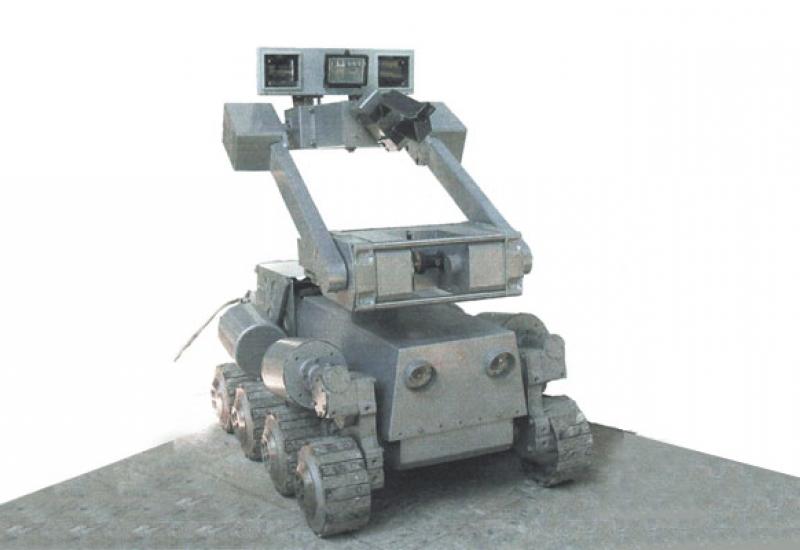Since 1994, the members of Intersectoral Research Institute of Mechanics "Rhythm" of the "KPI" fulfilled a number of development works to create a remote-controlled robotic systems for the liquidation of the Chernobyl catastrophe consequences, which can work at high levels of radioactivity, humidity and temperature.
Among the developments embodied in metal, we should firstly name the robotic complex for waterjet cutting of the steam-oxide pipes in under-reactor buildings in the destroyed 4th reactor (RTC-300 rubles).
The technological process of "cold" pipe cutting and grinding other materials (metals, concrete, composites) was provided by remote-controlled waterjet cutting system "Paser II", designed by "Flow international corporation" in the United States.
Some elements of the complex were manufactured at the enterprises of Kyiv, and the general assembly and testing of the complex was carried in the trunk №28 "KPI".
In August 1996 the work of the complex was demonstrated to the committee, consisting of the "Rhythm", Lawrence Livermore National Laboratory and the Department of Energy representatives.
The experience of the previous development was used to create a Radiation-resistant mobile robotic systems "RTK-100M", serving for visual, technical and radiation survey and various technological operations in the central hall and other premises of the "Shelter".
The adjustment of the technical task for RTK-100M and control of its execution were carried out by the US Lawrence Livermore National Laboratory representatives.
The training was conducted in build. №28 of the "KPI" on a specially mounted ground that provided maximum approximation to the real surface where the executive robot is supposed to move.
The acceptance testing of the complex with a positive result took place in the presence of the Lawrence Livermore Laboratory representatives in 2002.
During the period from 1998 to 2000 the Mobile remote-controlled complex "MP 711M" was developed and manufactured to work with radioactive waste, designed for loading, unloading, excavation, and a number of technological operations in terms of radioactive fields and radiation.
The complex is created on the basis of the Ukrainian mini excavator "ATEK 711A" on the principle of separation of the control cab and the crawler into two independent parts, the connection between which was provided with a radio channel.
In 2001, with the help of the "MP711M"complex an experimental radioactive waste discharge was successfully conducted at Kiev Specialized State Association "Radon".
In October, 2003, the "MP711M" complex was used during the international training "Dacia 2003" in the consolidated unit of the ME of Ukraine and successfully found and transported hazardous and radioactive items. Two "MP711M" complexes are used in the construction of "Shelter 2".
On the basis of the mobile RTK-100M chassis in 2003-2004 yy. the radiation resistant robotic exploratory complex "RTC-100R" to sample radioactive dust and aerosols in the central hall and other premises of Chernobyl 4th unit.
The complex consisted of the same main parts like RTK-100M, but in the design of the executive robot the original intake of radioactive dust was used together with a miniature vacuum device mounted on a rotating platform of the mobile chassis. The design of the corrugated tube intake ensured sampling of radioactive dust from the surfaces, oriented in space in any way.
The "RTC-100R" complex was shown at the Scientific Center in Slavutich, where it was highly evaluated.
The next project on Chernobyl theme of "Rhythm" was the creation of a radiation-resistant robotic downhole-pipe complex "RTC-30C". The complex served for automatic inspection of wells drilled into the reinforced concrete of the 4th power unit casing.
The complex provided automatic performance of the following functions:
- defining the design, the interior size and the overall length of the drills (pipes);
- detection of landslides, plugs, cracks, metal objects and fittings exits, and so on.
The technical capabilities of the complex can be extended by the following functions:
- measuring the ionizing radiation parameters of the wells length and in the premises or cavities;
- measuring of temperature, humidity, pollination along the length of the hole;
- analysis of the gaseous medium in the well or premises;
- determining the orientation of the hole (tubes) in space.
The implementation of these functions requires creating new functional modules mounted on enforcement work.
One of the main elements of the RTC, which provides these functions is, in particular, the vision systems with the original algorithmic software developed jointly with SKB FA (Lviv).
The remotely controlled (RC) executive robot (ER) prototype RTC-30C was manufactured and successfully tested in "KPI" and the vision system (VS) in the FA SDB in Lviv.
The last work of "Rhythm" together with STCU was to create a remotely - controlled complex for waterjet cutting of long-length multi-reactors "K-715".
The complex is designed for cutting various types of long radioactive rods when disposing them in the process of stopping the nuclear power plants operation.
By means of complex it was expected to replace the stations stationary guillotine shears which had a number of significant defects comparing to hydro cutters.
Complex "K-715" was designed, manufactured and assembled in the housing №28 "KPI" in 1998-2000.
The complex has received high praise from laboratory of the US Lawrence Livermore National Laboratory and Slavutych international research and technology laboratory representatives present at the testing

